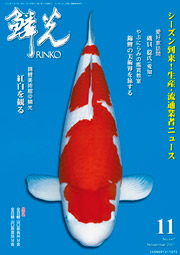Nostalgia of Kimi-Shigure
View All Rinko Magazine Issues We’ve Published Online.
Translation Team of IdeaWoman.JP
Miyu Knight -Translator, Flower Artist, Grapelog
Tomoko Payton – Live Event Painter/Portraitist, ATELIER PAYTON
Yuka Ono – Translator, Alex Japan Inc.
<Coordination>
Kaya Kiyokawa (Teramoto) – Urushi-Art/Gift Conciergie, IdeaWoman Co.
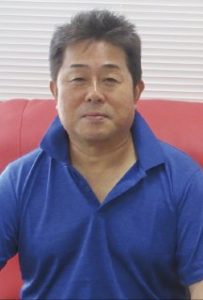
Shozo Miyoshi’s
Nishikigoi Renaissance
Memory recall, New discovery
Nostalgia of Kimi-Shigure
There was once a nishikigoi (Japanese brocaded-koi, a certain carp breed) named “Kimi-Shigure”. This koi named by Mr. Minoru Mano left this world without being noticed by public.
50 years since, Kimi-Shigure has revived again. What kind of memories recall to Mr. Shozo Miyoshi and his younger brother Tetsuo ———?
Prologue
I would like to tell you my story when I came across Kimi-Shigure again, since more than 45 years.
The first time I met this nishikigoi was at the Ogawa fish-farm in Nagasaki. In the cage was a strange brocaded-koi about 65 cm long. She wasn’t a small fish back then, and the moment her mixed pattern between Showa and Ki-Utsuri caught my father’s eyes, he started to roughly comb his sweptback hair. This was one of his gestures when he was fascinated by a certain koi.
“Ogawa-san, what koi brand is this?”, my father asked.
“I don’t care honestly… She’s a Showa fry I brought back from Niigata. She doesn’t turn red no matter how much I feed her ‘poison bun’, so I thought she might be a rare kind.”
At that time, Mr. Ogawa used to call Spirulina a “poison bun”.
“I think this koi has no red pigment cells. So, she doesn’t change color with redye-feed. She’s elegant and interesting, and I like her.”
Mr. Ogawa continued, “I had no doubt that Miyoshi-san, the man who raised Ochiba-Shigure, will of course understand this koi’s beauty.”
These words were unlike Mr. Ogawa’s usual ironic tone, and so my father was drawn in deeply.
I remember the koi’s price was very expensive, but my father seemed to have no second thoughts when he decided to take her.
I searched very hard for any pictures of this koi, but unfortunately there remains no trace.
So, try to imagine a Hi-Showa koi where its scarlet patches have all turned yellow, which shouldn’t be far off from how I remember it…
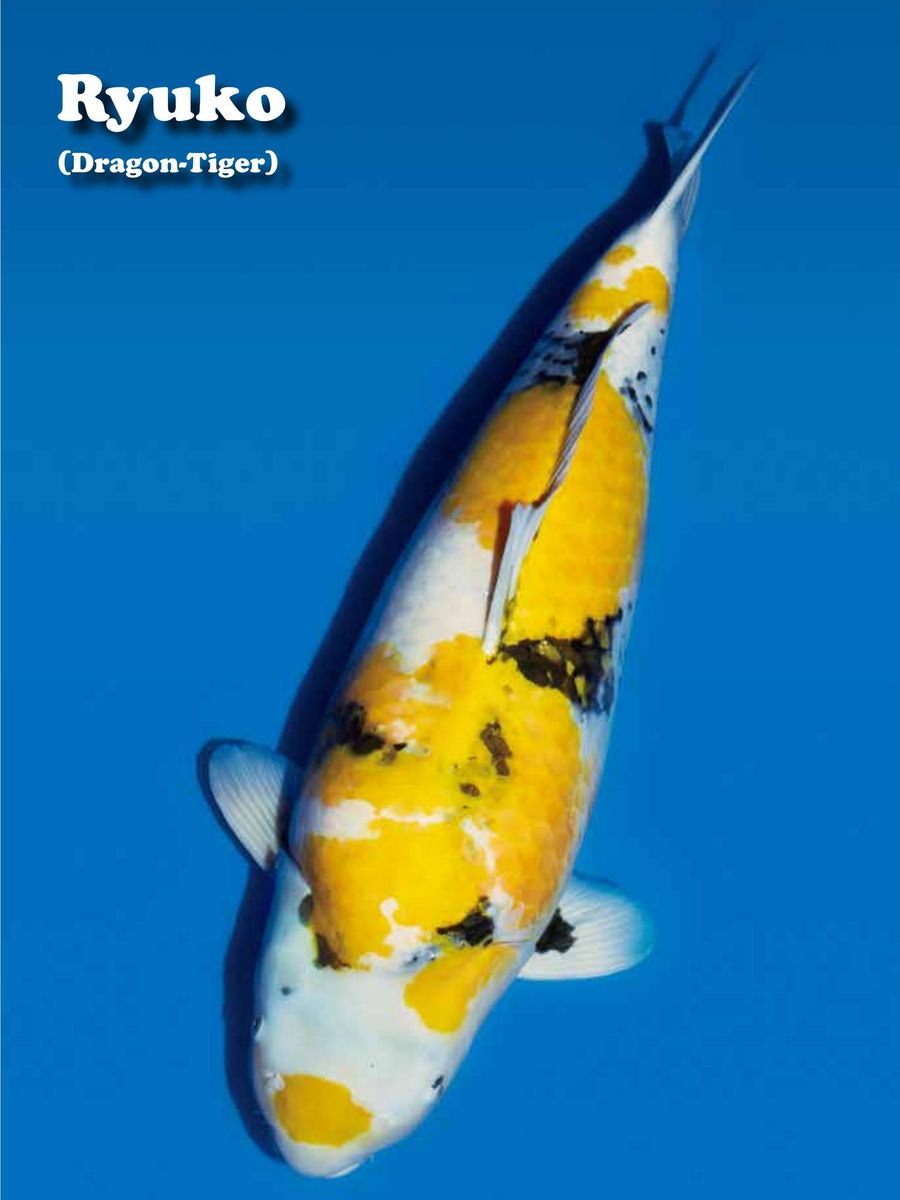
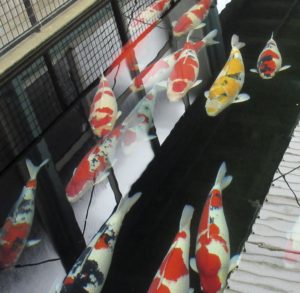
Yellow, which is considered to be the brightest chromatic color, is an expansive, warm and excitatory color. Also, because it evokes images of the sun and light, it brings excitement and joy. This is maybe why this color stands out so much in the swarm.
Mr. Minoru Mano is its Godfather
My father raised this yellow looking Showa koi in a concrete pool, because an ordinary pond won’t be easy to check her color change.
Since his first sight, my father seemed to have made up his mind who to offer this koi. And that was Mr. Susumu Kawanishi from Kagawa, who kindly purchased our Ochiba-Shigure’s first breed.
However, somehow my father didn’t offer this koi right away.
“I want to raise this koi myself for a year, and make sure she really doesn’t turn red”, he insisted.
And continued, “You know, if she turns red and comes out to be like another Showa-Sanshoku, that’s just a low-rank koi.”
“And I can’t let that ruin my reputation for my Ochiba-Shigure discovery”, he added.
Back then, I couldn’t understand my father’s feelings, and just didn’t receive this seriously.
To give the story away, the yellow Showa didn’t turn red at all, no matter how much she was fed redye-feed. I now realize that Mr. Heikichi Ogawa was right when he said the koi must be a mutation of Showa-Sanshoku that misses red pigment cells. Both yellow and red colors come from carcinoid pigments, but specifically, lutein and zeaxanthin perform the yellows, and astaxanthin perform the reds.
Kimi-Shigure must have been a mutation which astaxanthin doesn’t affect, and only yellow pigments like lutein and zeaxanthin affected her cells.
Soon after, Mr. Minoru Mano, the owner of Dainichi Koi Farm, occasionally visited us from Niigata and named the koi “Kimi-Shigure”.
“Even if no one buys her, I will!”
I remember Mr. Mano laughing, “Fans of the Hanshin Tigers baseball team will go crazy for this koi, so it shouldn’t take time for a big sell!”
Kimi-Shigure has gone beyond
My father gazed at the koi all day. I suppose he was crossing his fingers, ”Don’t turn red! Don’t turn red!”
Although while so, he took contradictionary actions that puzzled me. He kept feeding the most expensive redye-feed those days, chopped krill and carotenoid-rich peppers. Thinking back now, I think this was because he was taking strict measures to prove that the koi was missing red pigments.
Mr. Susumu Kawanishi, the owner of Ochiba-Shigure’s first breed, visited us often to check on the koi like he’d already owned her. It seemed like he couldn’t wait to see her swim in his pond back home.
But unfortunately, Kimi-Shigure shortly died only six months after she arrived at Mr. Kawanishi’s pond.
There was a time when the still alive Ochiba-Shigure’s first breed and Kimi-Shigure were both swimming in Mr. Kawanishi’s pond.
My father praised this koi display, “Ochiba-Shigure’s sober color matched perfectly with Kimi-Shigure’s vivid shade, as if they were yellow dancing leaves from a ginkgo tree. They were an indescribable beauty”.
Mr. Kawanishi once mentioned, “I sometimes regret that Kimi-Shigure should have been better off taken to Dainichi Koi Farm instead. Then, her offspring could have given birth to new breeds.”
Afterwards, my father explained that this loss of Kimi-Shigure might have been why Mr. Kawanishi offered his Ochiba-Shigure’s first breed so easily upon Mr. Mano’s request.
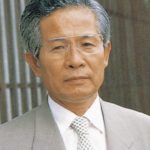 Founder of Ogawa Fish Farm
Founder of Ogawa Fish Farm
Mr. Heikichi Ogawa
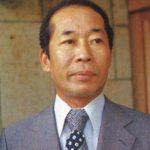
Mr. Susumu Kawanishi
 Former owner of Dainichi Koi Farm Mr. Minoru Mano
Former owner of Dainichi Koi Farm Mr. Minoru Mano
 My father Yukio, the man who discovered Ochiba-Shigure’s first breed, was a smart gentleman who never forgot his playfulness. He passed away at an early age, and I am shocked that I have now become older than him now. His sense of beauty was so incredible that even Mr. Minoru Mano, the former owner of Dainichi Koi Farm described him, “Your dad was such a sophisticated man.”
My father Yukio, the man who discovered Ochiba-Shigure’s first breed, was a smart gentleman who never forgot his playfulness. He passed away at an early age, and I am shocked that I have now become older than him now. His sense of beauty was so incredible that even Mr. Minoru Mano, the former owner of Dainichi Koi Farm described him, “Your dad was such a sophisticated man.”
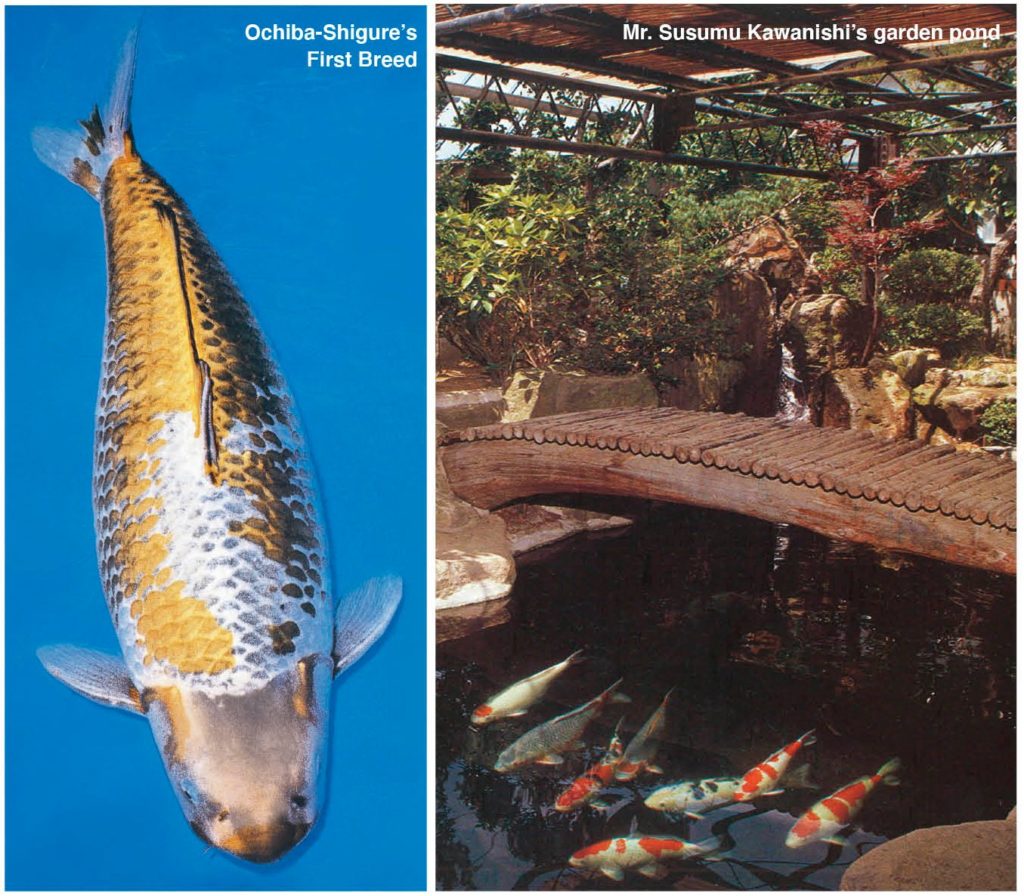 Ochiba-Shigure is well known nowadays, but nobody showed interest back when my father Yukio first discovered this breed. Only Mr. Susumu Kawanishi recognized the artistic value and kindly purchased her. Now this koi has become the one and only nishikigoi that can embody the beauty of withered. Her swimming with Kimi-Shigure in Mr. Susumu Kawanishi’s pond looked just like yellow dancing leaves from a ginkgo tree.
Ochiba-Shigure is well known nowadays, but nobody showed interest back when my father Yukio first discovered this breed. Only Mr. Susumu Kawanishi recognized the artistic value and kindly purchased her. Now this koi has become the one and only nishikigoi that can embody the beauty of withered. Her swimming with Kimi-Shigure in Mr. Susumu Kawanishi’s pond looked just like yellow dancing leaves from a ginkgo tree.
Time has passed
I had completely forgotten about Kimi-Shigure, not even in the corner of my mind. However, when I recognized a similar looking koi 45 years after, my heart was filled with an indescribable nostalgic feeling.
I used to keep this five-year-old koi in my pond, but I only thought she was another Dainichi-Showa that was waiting to turn red. Even when I replaced her from my pond when she turned two years old, I still thought she was a Showa only coloring slowly. I couldn’t blame myself, because I had never seen any Dainichi-Showa that doesn’t turn red.
Three years passed when she returned from Shimanto pond, and I thought she was ready to turn red this year. However, despite her imposing 80 cm size, the yellowish color was vivid more than ever. I couldn’t help but recall the old Kimi-Shigure. Although, these two koi couldn’t be related, since they had different origins, upbringing, and DNA.
I was gazing at the koi with surprise, and felt like I was bewitched by a fox or demon. But there she was, gracefully appealing her divine figure, “Look at me! Look!”. Her outstanding presence gripped my heart, and since a long time, I was somewhat able to understand my father’s fascination in the past with Kimi-Shigure’s first breed.
Unfortunately, I had no other trace to recall the Kimi-Shigure anymore, so I needed to move on. However, an unexpected helper showed up for me this year.
My younger brother Tetsuo came over for New Year’s, glanced at the central pond and whipered, “Ah… Kimi-Shigure… how nostalgic…”
“Huh? Do you know Kimi-Shi-gure?”, I couldn’t believe what I’ve just heard and asked back. He replied, “Of course I do. You remember I was dad’s driver during my college spring break for pocket money, right?”
He continued, “I’m the one who carried Kimi-Shigure to Kawanishi-san’s place with dad!” His story was something I had not expected, so I immediately turned my voice recorder on.
My brother outside the gate
It may sound bragging that I praise about my one-year junior brother Te-tsuo, but he had been watching nishikigoi since childhood and sure had very observant eyes for them. He was just like the Japanese saying, “the boy outside the temple gate can recite sutra without learning.” Even Mr. Minoru Mano noticed my brother’s talent and encouraged him to consider a career as a koi breeder, “Don’t spoil your gift!”, he insisted. So when I found out my brother remembered Kimi-Shigure, I thought to myself, “Yes, this will work!”
Confident that my brother’s story would be precise, I carefully listened to him with excitement.
The following is my brother’s story transcripted from my voice recorder.
x x x
Dad said, “Bring me Shozo’s new Cedric”, and tossed me your car key. I answered back, “No way, he’s going to get mad at me.”
I still remember dad’s response to that, and sometimes at work, it echoes in my mind like a guide.
“Listen, Tetsuo”, dad said, “No one has seen a yellow Showa before, and still, Kawanishi-san is willing to purchase such an unknown koi. I need to respect that, so I’m going to deliver her in a shiny new car! Any problem with that?”, and I knew there was no choice.
When we delivered the koi with your shiny waxed Cedric, Kawanishi-san didn’t say much, but sure looked happy. Perhaps he was touched with dad’s courtesy.
When we released Kimi-Shigure into his pond, she was a true beauty. Especially the moment when she mingled with Ochiba-Shigure, they were so facinating you could say I was almost tranced.
All three of us watched the koi in silence until sunset, then Kawanishi-san suddenly opened his mouth.
“Nishikigoi needs to be beautiful on their own, but they also need their special stage to swim like paintings on a canvas.”
I admired his point of view and thought that’s what makes Kawanishi-san an artist and a lacquer craftsman he is.
He advised me, “This is what your father Yukio Miyoshi is capable of! Don’t you forget that.”
Upon finishing Kimi-Shigure’s story, my brother laughed, “Since that day on, I actually did start to respect dad a little more. I could never forget my precious experience that day, no matter what.”
I never dreamt of me and my brother reuniting and discussing over koi at this age, despite us moving on to different paths.
Thanks to my brother’s bright memories of Kimi-Shigure, I was able to recall my vague memory and here I am writing this article.
Epilogue
The first emperor in ancient China was present 4,500 years ago, during their legendary era of myths and gods, while Japan was still in the Jomon-era. The emperor’s legend started with him being born out of the Yellow River (the Huang-He River), thus he was so called the “Yellow Emperor”. The reason why yellow became the most virtuous color in China, and why only emperors were allowed to dress in yellow, has its origins from this legend of the Yellow Emperor.
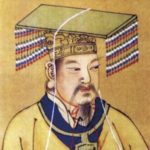
The Yellow Emperor. During the Song-era and Qing-era in China, yellow was an imperial color. Only the emperor was allowed to dress in this color.
In China’s Feng-Shui foretelling, yellow is said to increase wealth, improve human relation, and is effective when you want to lift your mood.
I don’t know if this is why, but around the end of last year, a friend of mine came to see my koi collection that just returned from the wild pond. My friend said, “I can’t tell why, but I feel like I’m blessed!”, and left with a hand-clapping worship towards Kimi-Shi-gure in her fish tank. The next day, my friend came back again to thank the koi for a big win at a pachinko slot machine. I had a tingling feeling as if my own luck was taken away.
Furthermore, my gardener was finishing the year-end pruning and claimed, “I won the LOTO 6 lottery!”, and was also worshiping to the koi.
I don’t fully believe that Kimi-Shi-gure’s charm is behind all of these auspicious events. But why shouldn’t I welcome any kind of good-luck stories for anyone, especially during these depressing days with the Corona-crisis.
Just like a kabuki actor, I had the urge to pose and shout out, “This is what you call an auspicious beginning of spring!”
As I said, yellow does bring me a delighting mood..

